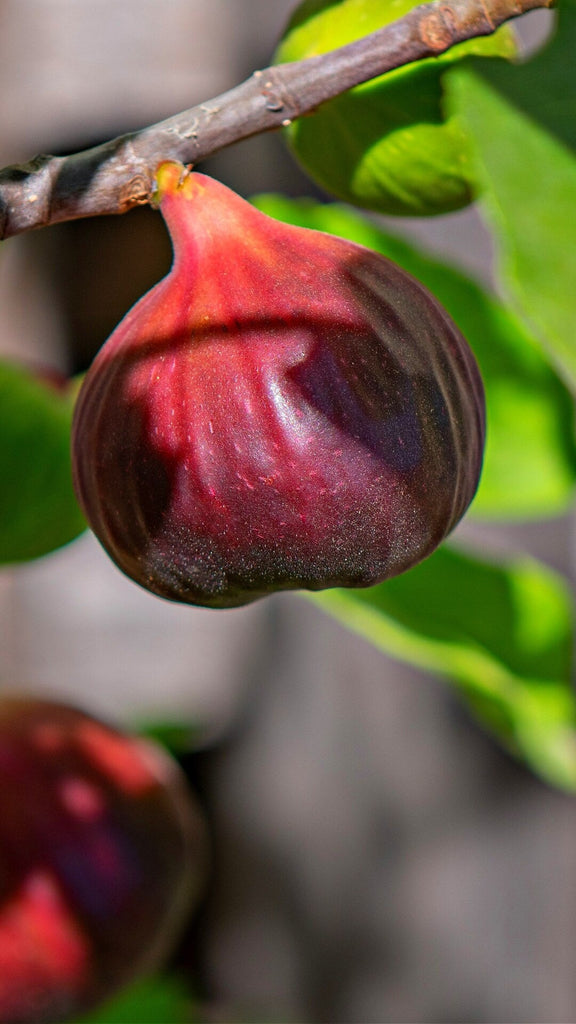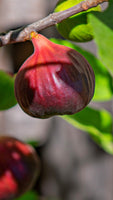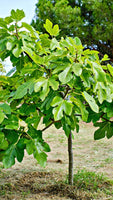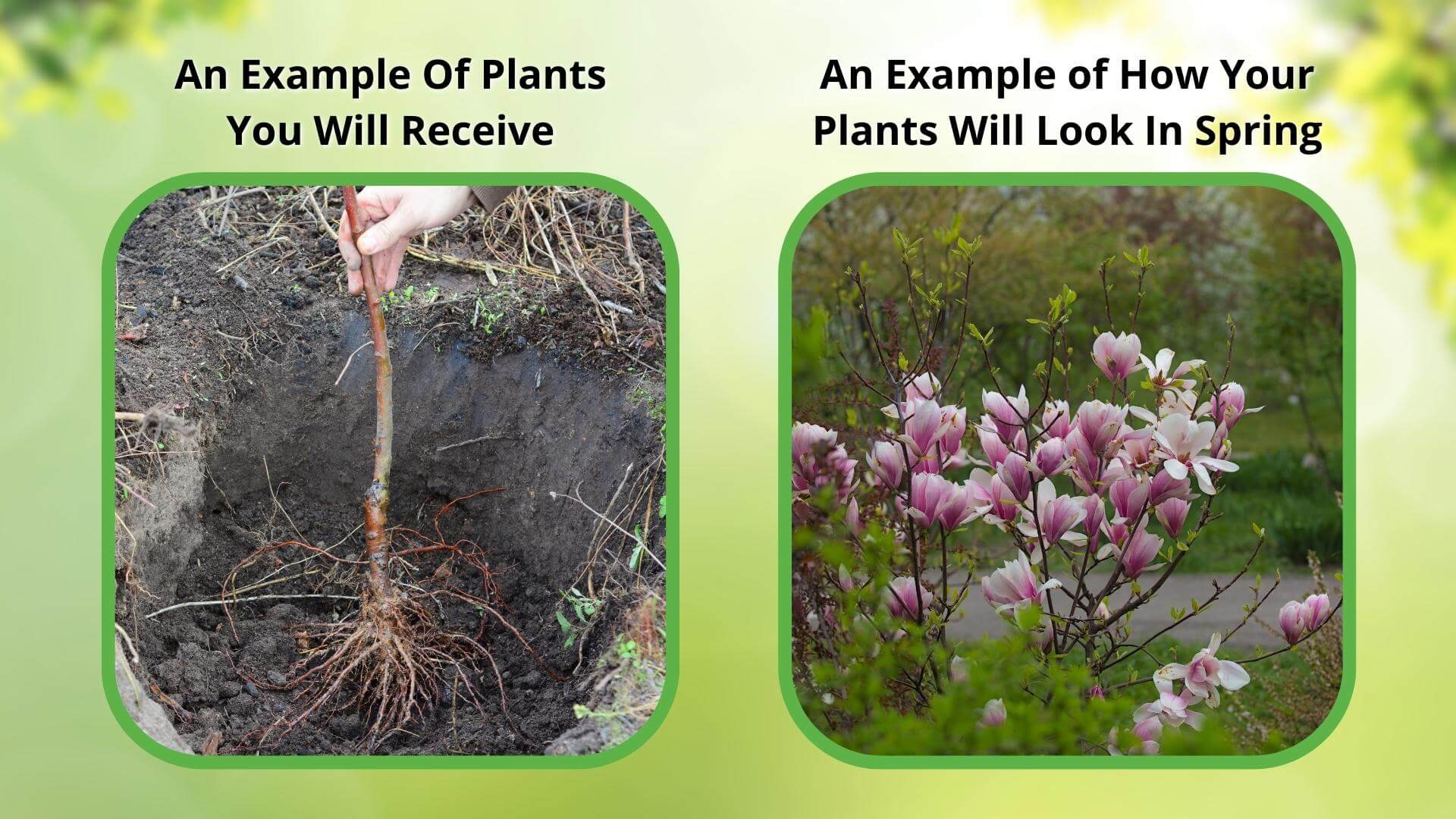



Couldn't load pickup availability
Ships in
Ships Spring 2026Add 1 plant to your cart, and the free one is automatically added.
Fig Trees for Sale
The Fig Tree is an ancient organism, cultivated by humans for centuries. It is native to the Mediterranean and parts of southwest and central Asia. It is part of the mulberry family and is a woody, deciduous, spreading tree that can also be described as a shrub based on its multi-stemmed composition.
The fruits of this tree are, of course, figs. Figs are edible, highly nutritious and delicious. They are eaten raw or dried, and commonly cooked into infinite dishes–savory and sweet–as well as used in jams, condiments and teas. This tree will be a great addition to your garden or yard, for its practical uses in the kitchen and its large, sprawling greenery.
Plant Details
Family: Moraceae
Light Requirement: Full sun, Partial shade
Water Needs: Moderate
Height: 15-30 ft
Spread: 15-30 ft
Growth Rate: Moderate
Soil Preference: Moist, well drained, does not tolerate alkaline soils
Season of Interest: Summer
Fruit: Red-Purple-Brown Figs
Wildlife Value: Mutualism with wasps; insects, wasps, and birds eat the fruit
Notable Characteristics of Fig Tree
The Fruiting Fig Tree has a unique pollination technique that works directly with wasps, in a process called mutualism, where both organisms need each other to survive. Tiny wasps live and lay their eggs inside the inedible, male figs, and in doing so, transfer pollen from one fig to another.
When the wasp eggs hatch, the males and females mate and chew a hole through the fig so the female can fly off to another fig and lay her eggs, repeating the cycle. The males are flightless so they often die trying to crawl out. If a female wasp makes her way to a female fruit, the pollen is still transferred but she can’t lay eggs due to the stylus and will die inside. Wasp corpses are absorbed into pure protein by the fruit, but it is still possible to find tiny wasps inside your figs when you cut them open!
Landscape and Maintenance of Fruiting Fig Tree
The Fruiting Fig Tree grows best in full sun but tolerates partial shade. It thrives in moist, well drained soils of all kinds, but does not tolerate alkaline soils. The lush, green foliage is plentiful and its many, layered branches tend to grow just as far out as they do upwards.
It can grow to reach 30 feet tall and wide, which is why it’s sometimes considered a shrub rather than a tree. Either way, if you have the space for this plant to thrive in your garden or yard, you will be glad you took a chance on it. It is lush, beautiful and you can’t beat its delicious fruits.
This Is How Your Plants Will Look upon Delivery

Height at Maturity
Under 25 Feet
Care
Brown Turkey Fig Trees thrive in well-draining soil and require regular watering, especially during dry periods. They should be pruned in late winter to promote new growth. Mulch should be placed around the base to maintain moistness and shield the roots from extreme temperatures. Fertilize the trees annually in early spring.
Plant Reproduction
Brown Turkey Fig Tree spreads by root suckers and seeds
How to Grow and Care for Fruit Trees
Fruit trees are a rewarding addition to any landscape, offering fragrant blossoms in spring and fresh, homegrown harvests in summer or fall. Popular varieties like apple, peach, pear, and plum thrive in full sun and well-drained, nutrient-rich soil. Choose trees suited to your USDA zone, and plant in early spring or fall for the best root development.
Dig a hole twice as wide as the root ball and deep enough so the root flare sits just above the soil line. Backfill with native soil, water deeply, and apply mulch around the base—keeping it a few inches from the trunk—to retain moisture and suppress weeds. Water regularly during the first growing season, especially during dry spells.
Prune annually to shape the tree, improve air circulation, and boost fruit production. Fertilize in early spring with a balanced or fruit-specific fertilizer. With proper planting, seasonal care, and a little patience, fruit trees will reward you with beauty, shade, and bountiful harvests year after year.
We carefully package every plant to retain superior moisture during transit. Once prepared, orders ship the same day through UPS or USPS, with typical delivery in 2–4 days.
Returns are not accepted, but plants are reshipped if extended warranty insurance was purchased at checkout. Otherwise, all plants include a standard 5-day warranty after delivery.



Caring Tips
How do I care for my Fig Tree?
Each box contains detailed care instructions and information about your product. But here's the basics.
Care Tips
Brown Turkey Fig Trees thrive in well-draining soil and require regular watering, especially during dry periods. They should be pruned in late winter to promote new growth. Mulch should be placed around the base to maintain moistness and shield the roots from extreme temperatures. Fertilize the trees annually in early spring.
Light Requirements
The Brown Turkey Fig Tree thrives best in full sun, receiving at least 6-8 hours of natural sunlight daily. It can tolerate partial shade, but consistent, bright sunlight achieves optimal fruit production and growth.
Hardy Planting Zones
6 • 7 • 8 • 9 • 10
This Fruiting Fig Tree’s roots are well-developed and robust, supporting vigorous growth and an excellent harvest of sweet figs.
The roots of this Fruiting Fig Tree were impressive, ensuring quick establishment and steady growth. Already enjoying delicious figs.
TN Nursery’s Fruiting Fig Tree has deep, healthy roots that guarantee strong growth and abundant fruit. Very satisfied with this purchase.
Healthy roots make all the difference! This Fruiting Fig Tree grew fast, anchored securely, and is now producing flavorful figs.
I was impressed with the dense roots of this Fruiting Fig Tree. It established quickly, grew vigorously, and is loaded with sweet figs.
